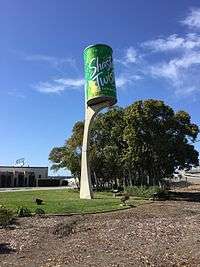Shasta (soft drink)
|
Shasta Twist decoration at the Shasta headquarters in Hayward, California | |
| Industry | Beverages |
|---|---|
| Founded | 1889, California |
| Headquarters | Hayward, California, United States |
Area served | United States |
| Products | Soft drink |
| Parent | National Beverage |
| Subsidiaries |
Shasta West Shasta Beverages International Shasta Midwest Shasta Northwest Shasta Sales Shasta Sweetener Corporation[1] |
| Website | http://www.shastapop.com |
_logo.svg.png) | |
| Type | Soft drink |
|---|---|
| Manufacturer | Shasta Beverages |
| Flavour | various |
Shasta Beverages is an American soft drink manufacturer which markets a value-priced soft drink line with a wide variety of soda flavors under the brand name Shasta Soda. The company name is derived from Mount Shasta and an associated spring.
History
Shasta began as The Shasta Mineral Springs Company at the base of Mt. Shasta, California, in 1889. In 1928, the name was changed to The Shasta Water Company. It produced bottled mineral water from Shasta Springs in Northern California. The water was poured into glass-lined railroad cars and shipped off for local bottling.
In 1931, Shasta produced its first soft drink, a ginger ale. Until the 1950s, the company's products were mainly mixers for alcoholic drinks: mineral water, club soda, and ginger ale.

Shasta introduced new marketing strategies in the 1950s,[2] which became industry standards: the packaging of soft drinks in cans, the introduction of low calorie soft drinks, and the distribution of cans and bottles directly to grocers through wholesale channels.[3]
By 1960, Shasta was a well-known brand in the western United States. During the 1960s, under the ownership of Luke Wienecke, Shasta was sold to Consolidated Foods (later known as Sara Lee) and was renamed Shasta Beverages. In 1985, it was acquired by the National Beverage Corp., which also owns the similarly marketed Faygo line of sodas.
Advertising
Ad campaign slogans over the years have included:
- "Shasta! It hasta be Shasta!" (1950s to present)
- "I want a pop, pop, pop! I want a Shhhhhhhhhhhasta, Shasta!" (1980s)
A 1984 Shasta commercial using the second listed slogan was featured in the 2002 M. Night Shyamalan film Signs in the scene where the old man complains about the number of soda commercials on television.
In 2009, the company launched a TV ad campaign and YouTube site.[4] The commercials show people being hit in the head with a can of Shasta, with the catch line "Some people wouldn't know a good deal if it hit 'em in the head."
Products
In addition to soft drinks, they produce the traditional mixers club soda and tonic water. Shasta introduced at one time a line of flavors targeting Hispanic customers.(‡)
Soda flavors
Shasta produces more than 30 varieties of soda,[5] including:
|
|
|
Former flavors
|
In 1993, Shasta produced 8oz cans, marketed to children, with flavors such as Mario Punch and Princess Toadstool Cherry.[6]
During 2003–2006, Shasta sold soft drinks called Shasta Shortz that were marketed to children. Shasta Shortz products were again packaged in 8oz 'mini cans' instead of the typical 12oz soda can, and had sweeter and more candy-like flavors.[7] Flavors included Bubble Gum, Camo Orange Creme, Chillin' Cherry Punch, Cotton Candy, Rah-Rah Root Beer and Red Grape Stain.
Ingredients
Shasta uses high fructose corn syrup as the sugar source in their drinks. Shasta diet soft drinks use sucralose and acesulfame potassium as non-nutritive sweeteners. Some of their sugar-based drinks, including their cola, use a combination of high fructose corn syrup and sucralose. Ingredients for some of their sodas are as follows[8] (in decreasing order by % of product):
- Diet Cola: carbonated water, caramel color, phosphoric acid, citric acid, potassium citrate, sucralose, potassium benzoate (a preservative), caffeine, acesulfame potassium, natural flavor
- Root Beer: carbonated water, high fructose corn syrup, caramel color, natural and artificial flavor, potassium benzoate
- Tiki Punch: carbonated water, high fructose corn syrup, citric acid, potassium benzoate, gum acacia, natural and artificial flavor, glyceryl abietate, red 40, sucralose, carbonated water, high fructose corn syrup, citric acid, natural and artificial flavor, potassium benzoate, sucralose, lactic acid, red 40
- Orange Soda: carbonated water, high fructose corn syrup, malic acid, gum acacia, potassium benzoate, glyceryl acetate, yellow 6, natural flavor, calcium disodium EDTA, brominated vegetable oil, citric acid, red 40
- Creme Soda: carbonated water, high fructose corn syrup, potassium benzoate, citric acid, caramel color, artificial flavor, sucralose
References
- ↑ "National Beverage." International Directory of Company Histories. The Gale Group, Inc, 2006. Answers.com 15 Jul. 2008.
- ↑ "History — Shasta". Shastapop.com. Retrieved 2012-10-22.
- ↑ Encyclopedia of Consumer Brands: Consumable products — Google Books. Books.google.com. Retrieved 2012-10-22.
- ↑
- https://www.youtube.com/watch?v=tkP6x38vlx8&feature=player_embedded Shasta YouTube Commercials - 2010
- ↑ "Flavors — Shasta". Shastapop.com. Retrieved 2012-10-22.
- ↑ "Sarasota Herald-Tribune". Google News. Retrieved 2013-03-05.
- ↑ "Mini Cans: Less is More". Businessweek. 2006-04-12. Retrieved 2012-10-22.
- ↑ product nutrition labels, ca. 2011
